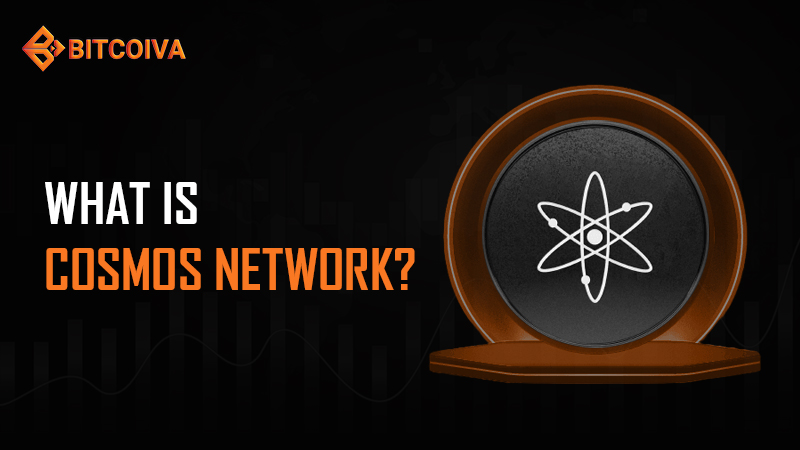Introduction
The blockchain space aims to create an enterprising project called the Internet of Blockchains. The network facilitates the interaction between blockchain networks for sharing data. In this blog, We will help you understand the Cosmos network, its use cases, and the pros and cons of this innovative technology.
What is Cosmos Network?
Cosmos Network, the Internet of Blockchain, is an independent, scalable, and interoperable decentralized network. The Tendermint team developed it to solve the blockchain industry’s most challenging scalability, usability, and interoperability tasks.
The primary idea behind it is to verify communications between multiple blockchains with each other. Communication can be achieved through several architectures, such as Cosmos Hub, Tendermint Core, and the Inter-Blockchain Communication (IBC) protocol.
Cosmos Hub:
The first blockchain launched in the Cosmos Network is the network’s central ledger. It connects various blockchains, called zones, and facilitates the transfer of tokens and data between them.
Tendermint Core:
Cosmos’s consensus algorithm provides a Byzantine Fault Tolerance (BFT) mechanism, ensuring the network’s security and reliability.
Inter-Blockchain Communication (IBC) Protocol:
A protocol that enables seamless communication and data exchange across different blockchains within the Cosmos ecosystem.
Cosmos Network provides a platform for developers to build custom blockchains using components tailored to specific use cases while maintaining interoperability with others.
Applications of Cosmos Network
Cosmos Network supports a wide range of applications, such as:
DeFi (Decentralized Finance):
Cosmos is popularly used to build applications for decentralized finance (DeFi). The applications developed by the Cosmos networks utilize the network’s features, including scalability and interoperability, to interact with other blockchains and protocols.
Cross-Chain Transactions:
The Cosmos Network’s cross-chain transaction features enable users to transfer assets and data between blockchains without requiring CEX (centralized exchanges). This functionality is widely used in decentralized exchanges (DEXs), which require multi-chain functionality.
Custom Blockchain Development:
The Cosmos SDK, a modular framework, simplifies the blockchain development process and allows developers to create custom blockchains for specific applications. Using this framework, developers can also create application-specific blockchains with unique features and governance models.
Supply Chain Management:
Supply chain management solutions can also be created using the Cosmos network, which requires transparency, traceability, and interoperability. By connecting different blockchain networks, Cosmos ensures that data is accurately recorded and easily accessible across various supply chain stages.
Gaming and NFTs:
Cosmos network enhances user experience and liquidity across different NFT and gaming platforms. The gaming industry can leverage Cosmos to exchange in-game assets and create decentralized non-fungible tokens (NFT) marketplaces.
Enterprise Solutions:
Enterprises utilize the cosmos to maintain control over their data and operations. Cosmos allows enterprises to build private, permissioned blockchains that interact with public blockchains.
Advantages of Cosmos Network
Cosmos Network offers numerous benefits, making it an appealing choice for developers, businesses, and users.
Interoperability:
Cosmos’s most significant advantage is its ability to facilitate interoperability between blockchains. This enables seamless communication and data exchange, breaking down silos and fostering collaboration across the blockchain ecosystem.
Scalability:
Cosmos addresses the scalability issues that trouble many existing blockchain networks by creating independent blockchains that can operate in parallel. Cosmos ensures the network can handle a high volume of transactions without congestion.
Customizability:
Custom blockchains can be developed using the Cosmos SDK, which allows developers to tailor specific use cases.
Security:
The Tendermint Core consensus algorithm provides robust security through Byzantine Fault Tolerance (BFT). BFT ensures security and operation even in the presence of malicious actors in the network.
Decentralization:
Cosmos promotes decentralization by enabling the creation of independent blockchains that are not subject to the control of a single entity.
Community-Driven Development:
Cosmos is an open-source project with a vibrant community of developers and contributors. These community-driven approach fosters innovation and ensures that the network continues to evolve in response to its users’ needs.
Disadvantages of Cosmos Network
While Cosmos offers numerous benefits, it also has some disadvantages and challenges that need to be addressed:
Complexity:
The Cosmos Network’s architecture can be complex, particularly for developers new to the platform. Building and maintaining a custom blockchain within the Cosmos ecosystem requires a deep understanding of the technology and its components.
Adoption Challenges:
Despite its potential, Cosmos needs help in achieving widespread adoption. Competing blockchain platforms, such as Polkadot and Ethereum 2.0, also offer interoperability and scalability solutions, making it difficult for Cosmos to establish itself as the dominant player.
Dependence on Tendermint:
Cosmos’s security and functionality heavily rely on the Tendermint Core consensus algorithm. Any vulnerabilities or limitations in Tendermint could impact the entire Cosmos Network.
Inter-Chain Security Risks:
While Cosmos facilitates interoperability, it also introduces new security risks related to inter-chain transactions. Malicious actors could potentially exploit vulnerabilities in one blockchain to compromise other connected blockchains.
Regulatory Uncertainty:
Like other blockchain projects, Cosmos operates in a regulatory gray area. The lack of clear regulatory guidelines for cross-chain transactions and decentralized finance could challenge the network’s growth and adoption.
Competition:
Cosmos faces stiff competition from other interoperability-focused blockchain projects like Polkadot and Avalanche. These projects also offer unique features and advantages, making it challenging for Cosmos to differentiate itself and attract developers and users.
Conclusion
The Cosmos Network is a groundbreaking project aiming to create an interconnected, scalable, decentralized blockchain ecosystem. Its focus on interoperability, scalability, and customizability makes it an attractive option for developers and businesses looking to leverage blockchain technology. However, the network faces challenges, including complexity, adoption hurdles, and competition from other projects.
As the blockchain industry continues to evolve, Cosmos’s success will depend on its ability to address these challenges and differentiate itself in a crowded market. With its strong community and innovative technology, Cosmos has the potential to play a significant role in shaping the future of the blockchain ecosystem.
Visit: www.bitcoiva.com

